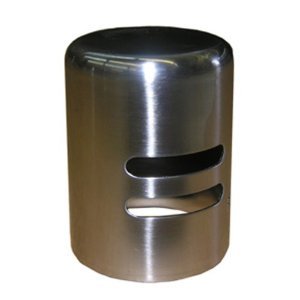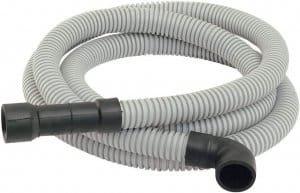Having a dishwasher in the home is a great convenience for any family, but when it stops draining correctly, the dishes remain wet and can cause major disruption to a busy household. If your GE dishwasher is not draining properly, there are a few common causes that could be behind the issue. This article will explain why your GE dishwasher might not be draining and what you can do to fix it.
Table of Contents
Why is my GE Dishwasher not Draining?
If you’re having trouble with your GE dishwasher not draining properly, it could be due to a few different possible issues. The first thing to check is the filter screen in the bottom of the dishwasher. This can become clogged over time and will prevent water from draining correctly. To clean it, remove the lower rack and unscrew the filter cover located usually at one end of the base interior. Remove any debris or residue that may have built up in there before replacing and closing securely.
Another common issue could be a clog or blockage in either the drain line or pump itself. If this is suspected, disconnecting power to your dishwasher and disconnecting both hoses going into and out of your unit will help to fully inspect what’s going on inside.
Common Causes:
A broken or clogged GE dishwasher that won’t drain can be a frustrating problem. Fortunately, many common causes of drainage issues are easily solvable. In this article, we’ll discuss some of the most common reasons why a GE dishwasher may not be draining properly.
The first and most obvious cause is an obstruction in the drain hose or sink drainpipe. This could be caused by anything from food particles to small pieces of cutlery blocking the drain’s flow. To fix this issue, simply locate the obstructing item and remove it with a pair of pliers or tongs. Additionally, you should inspect your dishwasher’s filter for any signs of buildup or blockage as well as check for any kinks in the hose itself.
Clogged Drain Hose
One of the most common issues with GE dishwashers is a clogged drain hose. If your GE dishwasher is not draining properly, it could be due to a clog in the drain hose. This can cause water to back up and pool at the bottom of the appliance. To prevent water from overflowing, it’s important to address this issue quickly and efficiently.
Fortunately, clearing out a clogged drain hose isn’t too difficult for an experienced do-it-yourselfer. The first step is to locate where the dishwasher’s drain hose connects to either the sink or garbage disposal. You’ll want to disconnect this connection and examine it for any visible obstructions or blockages in the line that may be causing your drainage problems. If you find one, carefully remove it using pliers or another appropriate tool before replacing and reconnecting the line.
Dishwasher Air Gap
If your dishwasher isn’t draining properly, it’s important to take a closer look at the air gap and high loop. The air gap is designed to prevent backflow of dirty dishwater into the clean water supply. It looks like a metal cylinder with two hoses attached, one from the sink drain and one that goes back into the drainage system. If this is clogged or not installed correctly, water won’t be able to drain freely.

The high loop is an additional piece of plumbing located in between the drain line and garbage disposal connection. Its purpose is to keep wastewater flowing away from your dishwasher instead of siphoning back into it when you run your disposal or faucet in another part of your kitchen. If this loop was installed too low, water may not go all the way up before spilling out or could be blocked by debris buildup in the line.
Dishwasher’s Drain Solenoid
If you’ve noticed that your dishwasher is not draining, it may be due to a faulty drain solenoid. This small component is responsible for controlling the flow of water in and out of the machine. Fortunately, testing the drain solenoid is relatively straightforward and can help identify whether or not this part needs to be replaced.
The first step in testing the drain solenoid is to unplug your dishwasher from its power source. Once it’s unplugged, locate the drain solenoid on the back of your unit and disconnect any electrical wiring that connects it to other components. Then use a multimeter set to “ohm” mode to measure resistance across each pair of terminals on the solenoid; if you get readings between 10-20 ohms then the part is likely working properly.
Faulty Motor
GE dishwashers are known for their reliability and efficiency, but unfortunately, sometimes a faulty motor can lead to major problems. The most common issue is when the dishwasher won’t drain correctly. This can be the result of a faulty motor or blocked drainage pipes.
At this point, it’s important to identify and diagnose the underlying cause before attempting to fix it yourself. If the problem lies with the motor itself, it may be necessary to replace or repair it in order to get your dishwasher up and running again. However, if a clogged drainage pipe is at fault, then simple cleaning and unclogging may be enough to restore normal function.
Broken Float Switch
If your GE dishwasher is not draining properly, it could be due to a faulty float switch. A float switch is an important component within your dishwasher that helps regulate the water level. When this switch malfunctions, it can cause your machine to become flooded or fail to drain properly.
To check if this is the problem with your GE dishwasher, locate the float switch in the bottom of the appliance near the sump area. The float should be visible and move freely up and down when pressed gently with a finger. If it doesn’t move freely or fails to come back up after pushing it down, then you have likely identified your problem: a broken float switch.
Replacing a faulty float switch is relatively simple but will require some basic disassembly of your dishwasher – so make sure you’re comfortable before attempting any repairs yourself!
How to fix ge dishwasher not draining (Step by Step Troubleshooting?

If your GE dishwasher isn’t draining properly, you don’t have to call for a professional repairman right away. Troubleshooting the issue yourself can save time and money. In this article, we’ll provide step-by-step instructions on how to diagnose and fix common dishwasher drainage problems. With a few basic tools and a little bit of patience, you’ll soon have your dishwasher back in working order.
Step 1: Check Drain Hose

The first step you should take to address the issue is to check the drain hose. The drain hose is a flexible tube connecting your dishwasher’s pump and motor assembly to your home’s plumbing system. It carries wastewater from the dishwasher, so a blockage or kink in this hose can cause water to back up into the dishwasher.
To check that your drain hose isn’t clogged or blocked by debris, unplug the power cord and remove any debris you can see on or around the drain hose connection. Inspect both ends of the hose for any signs of damage like cracks, and make sure it has been properly connected without being pinched or kinked.
Step 2: Inspect Motor
The next step in getting it fixed is to inspect the motor. The motor is responsible for pumping out water during the cycle and if it’s not working properly, your dishes won’t be clean. Most dishwashers have an easily-accessible access panel on either the front or side of the machine that can be removed to expose the internal components.
Once you’ve opened up the access panel, take a look at all of the visible parts to ensure nothing looks loose or damaged. If everything appears to be in order, then you’ll need to check for power going into and coming out of the motor itself. This may require a multimeter and some basic electrical knowledge—if you’re uncomfortable taking on this type of task yourself, contact a qualified repair technician for assistance.
Step 3: Replace Float Switch
The float switch senses and monitors how much water is in the dishwasher tub during a cycle and tells the drain pump when to turn off. If this component malfunctions, it can compromise your dishwasher’s ability to drain. Fortunately, replacing the float switch is a simple repair that you can complete yourself with basic tools.
To start, shut off the power to your dishwasher at both its breaker panel and unplug it from its outlet. After you’ve done so, locate and remove the inspection panel or kickplate on the front of your machine. With this removed, you’ll be able to access all internal components including wires and connections leading up to the float switch which should be located near the bottom of your dishwasher tub.
Make Sure to take a Professional Assistance if all those Method Fails:
If you are experiencing an issue with your dishwasher not draining properly, it can be very frustrating. With a few simple steps, however, you can diagnose the problem and potentially fix it yourself. If these methods do not work, you should consider taking professional assistance to help resolve the issue.
An experienced technician can usually provide a fast and accurate diagnosis of what is wrong with the dishwasher and suggest the best way to proceed. They may also have access to specialized tools that allow them to more accurately identify problems with drains or pipes.
By taking professional assistance from an expert in appliance repairs, you will likely save yourself both time and money when trying to fix your dishwasher’s drainage issues. A qualified technician is often able to quickly identify any underlying problems in order to ensure that your appliance runs as expected for many years into the future.
Why is my GE dishwasher not draining at end of cycle?
There are a few possible reasons why your GE dishwasher is not draining at the end of its cycle.
First, check to make sure the drain hose is properly connected and not clogged or kinked. If it is, straighten out the hose and ensure that it is securely attached to both the dishwasher and the garbage disposal or sink drain. Additionally, if you have an air gap installed in your sink, make sure this is clear of any debris.
Second, check to see if there is a blockage in the pump filter located inside the dishwasher. This can be accessed by opening up the bottom panel of your dishwasher. If you find any food particles or other debris blocking the filter, remove them and clean out any remaining residue with a damp cloth.
Finally, if none of these solutions work, then you may need to replace certain parts of your dishwasher such as the motor or pump assembly.
Conclusion:
Dishwasher not draining is a common problem that can be caused by several factors. The most likely cause is a clogged drain hose, a faulty pump, or a damaged float switch. A DIYer can easily troubleshoot and diagnose the issue, but it is always recommended to consult with an appliance repair specialist if needed. Regular maintenance helps to prevent further problems in all major home appliances.

